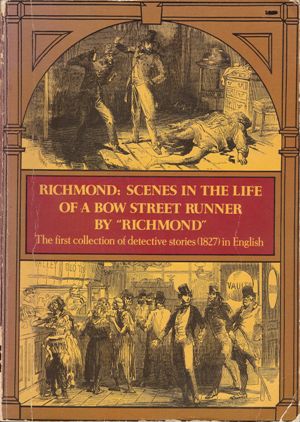 We’re on a huge vintage authors hunt here this month. We’ve discovered Melville Davisson Post (thank you, Elisabeth Grace Ford) and Rafael Sabitini (thank you, Donna Montgomery)!
We’re on a huge vintage authors hunt here this month. We’ve discovered Melville Davisson Post (thank you, Elisabeth Grace Ford) and Rafael Sabitini (thank you, Donna Montgomery)!
We’ve talked about great names (Doomdorf and Rafael), brilliant historical setting, gripping character dilemmas, authentic details, the perfect story structure for which we all strive, and why, when we ask, “Must life be so devastating?” we must ask Freddie Mercury.
We’ve even learned the definition of the term Scaramouche and why we can blame him whenever someone on the Internet has the bad sense to be wrong.
So while I’m showing you the covers of some of my latest favorites, I’m going to talk today about what is possibly the oldest book of detective stories in the English canon: Richmond: Scenes in the Life a Bow Street Runner, published under the pseudonym “Richmond” in 1827.
-
Edgar Allan Poe
Now, we all know Edgar Allan Poe is credited with creating the Western mystery genre with “The Murders in the Rue Morgue,” which story has the extraordinary distinction of featuring orangutangs in mid-nineenth-century Paris with an overwhelming penchant for chimneys.
Be that as it may, that story is widely considered the first story of purely fictional detection.
Oddly enough, Poe died under highly mysterious circumstances, found incoherent on the streets of Baltimore after a disappearance of three days which have never been accounted for, wearing another man’s clothes and calling the name of a stranger.
No one knows what happened to him during those three days.
-
Emile Gaboriau
Some ten years or so later, the French author Emile Gaboriau earned the title of the first author of a full-length Western mystery novel, L’Affaire Lerouge (which I am reading right this minute).
I’m going to tell you a quick secret here: I was in my local second-hand bookshop the other day, doing my darnedest not to scan the mystery shelves for fear I’d find something I couldn’t afford that I simply could not live without, when what do you think happened—I discovered a matching set of hardback Gaboriau published in the 1910s.
There were six of them. Ooh, la-la!
Now all I need are the other six.
Anyway. . .again, oddly, Gaboriau died young, at the age of 40, apparently of a heart that literally burst.
A strange accident indeed.
-
“Richmond” aka Anonymous
The point of all this is that, about thirty years before Poe invented the first detective story, London had finally gotten around to creating something vaguely resembling a police force—not a real police force; the British politicians of the time didn’t want their liberties limited by a real police force, like those poor people in the great cities of other nations—but a small, hardy crew of assistants to the British judicial system, which happened to be located in Bow Street in London.
This team of criminal investigators was known as the Bow Street Runners.
I suppose because they ran around a lot.
It was their job to hunt down the clues to crimes and bring them back to the judges of Bow Street, along with—hopefully—some deductions as to the methods, means, and motives of the crimes, so criminals (who really were out of hand at that time. . .Horace Walpole was apparently held up by a highwayman on a London street) could be brought to justice.
And somebody—nobody knows who—eventually set down the first known series of stories about these investigators’ adventures.
But nobody knows who.
As was common in that day, the book was published anonymously, ascribed only to the mythical protagonist “Richmond.” It was dismissed by the reading public and quickly sank entirely from view.
And yet it was a landmark book.
At first an ordinary ‘picaresque’ (a romantic adventure story, involving forbidden love, high-jinks with a traveling theatrical troupe, tragic death of a beloved, and what appear to be the most authentic gypsies in English literature), it evolves in the second half into a series of Bow Street Runner investigations of five crimes, almost all of which can be traced to actual crimes solved by the Bow Street Runners and reported in the newspapers in the years before Richmond appeared.
Here lie the seeds of all mysteries of the genre to come: crime scenes, clues, interrogations, red herrings, dead ends, even a pincer operation between the Bow Street Runners and the erstwhile Coast Guard—which actually occurred.
There are a lot more thefts of dead bodies than normally turn up in modern mysteries. (Apparently, this was a serious problem in early nineteenth-century England.)
And of course everyone drinks a whole lot of brandy.
But this is it, people: the original author of our mystery genre, one of the best selling genres of our day—
Anonymous.
Who was it?
Now there’s a mystery dying to be solved!
